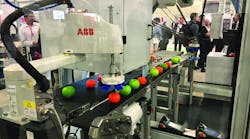When I wrote this column last month, my thoughts were on electric vehicles (EVs) and all the ways in which the growing electrification of transportation is changing our world.
This month, I can’t seem to get away from the robots. Yes, robots, robotics. Some of it started in early March at ABB Customer World in Houston. My intent was to go there and collect more and varied information on ABB’s latest efforts in transportation electrification — everything from new high-capacity EV passenger vehicle charging stations to the world’s first autonomous all-electric passenger bus in Singapore. And I did — get all that information, that is.
But looking up on the board for the myriad educational break-out sessions at the conference, one word kept jumping out at me — robotics.
Then I went down to the show floor or exhibit hall. Terrific displays of the latest technology to automate and digitize transmission, distribution, utility operations. Fascinating stuff for anyone who works on the lines, networks, and substations of today and what is being planned for tomorrow. And then, in the center of the showroom, robots. Plenty of robots.
One that rapidly, efficiently, and without pause picked out tomatoes from a line of tomatoes and green apples on a conveyer belt filled with many apples onboarded just seconds before. The robot never missed. A packaging robot next to this did the same with mail packages, snapping up each one, moving it into place on a sorter in perfect orientation for the next step — presumably labeling — likely to be done with another automated robot.
Just beyond that, one of what ABB calls a “collaborative robot” — co-robotics is I think the term being used for robots that are programmed to interact with humans and respond to our verbal and even non-verbal instructions — served perfect little cups of espresso to those who requested them. (Note that the George Brown Convention Center had its own “Coffee Robot” just outside the exhibit hall, with signage directing all to it for a cup of java on the run).
These robots almost immediately reminded me of the Tipsy Robot my wife and I enjoyed watching in Las Vegas last year — a long, white, single-armed contraption that comes down from the ceiling, grabs a cup, gets you ice, finds the alcohol, and adds mixes to your cocktail order as you wait for it to come sliding down a chute in the counter to your waiting hands and thirsty lips. No small-talk from the bartender, but then again, I suppose one is saving on tips.
Anyway, back to Houston, the next thing I noticed was a large display screen showing “the Factory of the Future.” Gosh, was that factory efficient. Things were being delivered and assembled along an assembly line, then going out the door with remarkable, unstoppable efficiency. And of course, you guessed it — all was being done by robots. No human actors involved, at least in this representation.
And then the coup de grace, so to speak. I heard about the “TXplore” robot, my favorite of the show. TXplore may not sound like much, but it’s a perfect use of robotics to do one of the jobs robots should — and hopefully WILL — be largely employed for at least in the short term. It’s a relatively small elongated-cube-shaped device perhaps one foot in each dimension. Maneuvered by remote control, the TXplore is placed inside oil-filled transformers to “swim” through the oil and report back on material conditions within the machine. It can send back real-time images and videos from inside the transformer as well as take readings on all types of chemical analysis of the oil and/or gases, or other substances within the transformer tank.
The TXplore is, again, representative of the best that robots can do for us — they can take away the jobs that are, as one speaker at ABB World put it, the most “dull, dangerous and dirty” we have. In the case of this little swimming robot, humans no longer have to drain, enter, inspect, and then refill and reseal a transformer with oil. Human medical staff does not need to be on-hand or on-call in the case of an inspector injuring himself or herself entering or exiting the tight, sometimes dangerous and dirty or oily inside of a transformer. Nobody needs to take a break during inspection or concern themselves with dangerous fumes or toxicity. Downtime is reduced from a week or weeks to mere days at most — in the right conditions, once could even presume a few hours of inspection would suffice.
One can, and probably should, also imagine that robots are the future if not the present for manhole and underground conduit inspection, overhead lines (a flying robot is nothing if not a drone or UAV by another name), particularly over large masses of water, protected wetlands, in difficult or treacherous places to reach.
One can and should imagine, then, that the robots are, in fact coming, if not already here. We will continue to follow their development and use in the utility space, but in the meantime, for an introduction to one of our current favorites, read on here and/or go to our website at www.tdworld.com, where we feature pictures and some short video clips of the TXplore as well as other robots seen at ABB Customer World.


